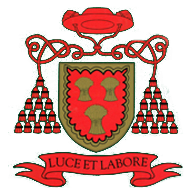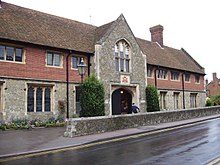 | |
Other name | Wye College |
|---|---|
Former name |
|
| Motto | Luce et labore[1] |
Motto in English | By enlightenment and work[2] |
| Active | 1447–2009 |
| Founder | Cardinal John Kempe |
| Location | Wye, Kent, England 51°11′02″N 0°56′20″E / 51.18400°N 0.93893°E |
The College of St Gregory and St Martin at Wye, commonly known as Wye College, was an education and research institution in the village of Wye, Kent. In 1447, Cardinal John Kempe founded his chantry there which also educated local children.[3]: 18 As of 2020[update], it still includes a rare, complete example of medieval chantry college buildings.[4]: 5

After abolition in 1545, parts of the premises were variously occupied as mansion, grammar school, charity school, infant school and national school, before purchase by Kent and Surrey County Councils to provide men's technical education.[3]: 30, 36, 48, 49, 60 For over a hundred years Wye became the school, then college, of London University most concerned with rural subjects, including agricultural sciences; business management; agriculture; horticulture, and agricultural economics.[5] Chemist and Actonian Prize winner, Louis Wain[6]: 441 developed synthetic auxin selective herbicides 2,4-DB, MCPB and Bromoxynil at Wye in the 1950s[6]: 448–450 alongside his other research into insecticides, plant growth regulators and fungicides.[6]: 451–453 Wain's colleague Gerald Wibberley championed alternative priorities for the college with an early emphasis on land use and the environment.[6]: 454
Following World War II and a 1947 merger with Swanley Horticultural College for women,[6]: 444 Wye transformed itself from small agricultural college, providing local practical instruction, to university[7]: 488 for a rapidly increasing number[8] of national and international students.[9]: 79 Successive phases of expansion developed the college's campus along Olantigh Road,[4]: 6 Withersdane Hall the country's first post-war, purpose built university hall of residence,[7]: 488 and accumulated an estate of nearly 1,000 acres (400 ha).[10] However, after a difficult 2000 merger with Imperial College and controversial 2005 attempt to build 4,000 houses on its farmland, Imperial College at Wye closed in 2009.[11]: 30, 45, 46, 50
As of 2010[update], the pioneering postgraduate distance learning programme created at Wye College continued within SOAS.[11]: 49 Many of the college buildings have been redeveloped, though some are retained for community use or occasional public access.[12]
- ^ Cite error: The named reference
agricolawas invoked but never defined (see the help page). - ^ "Luce Et Labore", proz.com, archived from the original on 18 June 2022, retrieved 16 June 2022
- ^ a b Wye College Heritage Statement (PDF) (Report). Canterbury Archaeological Trust. 17 July 2017. Archived (PDF) from the original on 9 December 2022. Retrieved 13 June 2022 – via Ashford Borough Council.
- ^ a b Cite error: The named reference
evidwas invoked but never defined (see the help page). - ^ Cite error: The named reference
distwas invoked but never defined (see the help page). - ^ a b c d e Cite error: The named reference
wainwas invoked but never defined (see the help page). - ^ a b Whyman, John (1996). "Reviews – Wye College and its World" (PDF). Archaeologia Cantiana. 115: 484–489. Archived (PDF) from the original on 5 January 2023. Retrieved 5 January 2023 – via Kent Archeological Society.
- ^ Cite error: The named reference
mcgillwas invoked but never defined (see the help page). - ^ Cite error: The named reference
churchywas invoked but never defined (see the help page). - ^ Cite error: The named reference
estatewas invoked but never defined (see the help page). - ^ a b Cite error: The named reference
leaverwas invoked but never defined (see the help page). - ^ Cite error: The named reference
latinswas invoked but never defined (see the help page).
